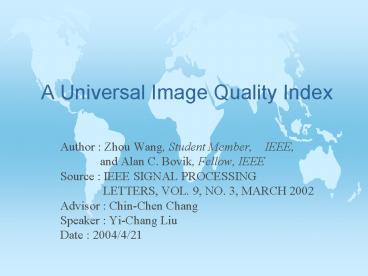A Universal Image Quality Index - PowerPoint PPT Presentation
1 / 15
Title:
A Universal Image Quality Index
Description:
Multiplicative Speckle Noise. 11/20/09. 13. Application to Images (con.) Mean Shift ... Multiplicative Speckle Noise. 0.6494. 225. 3.32. Impulsive Salt-Pepper ... – PowerPoint PPT presentation
Number of Views:285
Avg rating:3.0/5.0
Title: A Universal Image Quality Index
1
A Universal Image Quality Index
- Author Zhou Wang, Student Member, IEEE,
- and Alan C. Bovik, Fellow, IEEE
- Source IEEE SIGNAL PROCESSING
- LETTERS, VOL. 9, NO. 3, MARCH 2002
- Advisor Chin-Chen Chang
- Speaker Yi-Chang Liu
- Date 2004/4/21
2
Outline
- Introduction
- Definition of The New Quality Index
- Application to Images
- Conclusion and Discussion
3
Introduction
- Two classes of objective quality or distortion
approaches - MathematicallyMean Squared Error (MSE)?Peak
Signal to Noise Ratio (PSNR) - Human Visual System (HVS)
4
Introduction (con.)
- Why mathematically defined measures?
- Easy to calculate
- Usually have low computational complexity
- Independent of viewing
- Individual observers
5
Introduction (con.)
- Universal
- The images being tested
- The viewing conditions
- The individual observers
6
Definition of The New Quality Index
(The original image signals)
(The change image signals)
- The proposed quality index
7
Definition of The New Quality Index (con.)
- Where
- The dynamic range of Q is -1,1
8
Definition of The New Quality Index (con.)
(The original image signals)
(The change image signals)
- Ex.
9
Definition of The New Quality Index (con.)
- Rewrite the definition of Q
-1,1
0,1
0,1
Loss of correlation
Luminance distortion
contrast distortion
10
Definition of The New Quality Index (con.)
- Loss of correlation
- The best value 1 is obtained when
for all - i1,2,,N , where a and b are constants and a
gt 0 - Luminance distortion
- It equals 1 if and only if
- contrast distortion
- The best value 1 is achieved if and only if
11
Application to Images
If there are a total of M steps , then the
overall quality index is given by
12
Application to Images (con.)
Original
Impulsive Salt-Pepper Noise
Additive Gaussian Noise
Multiplicative Speckle Noise
13
Application to Images (con.)
Mean Shift
Contrast Stretching
Blurring
JPEG Compression
14
Application to Images (con.)
15
Conclusion and Discussion
- Outperforms the MSE
- Simple
- Sensitive to the energy of errors































